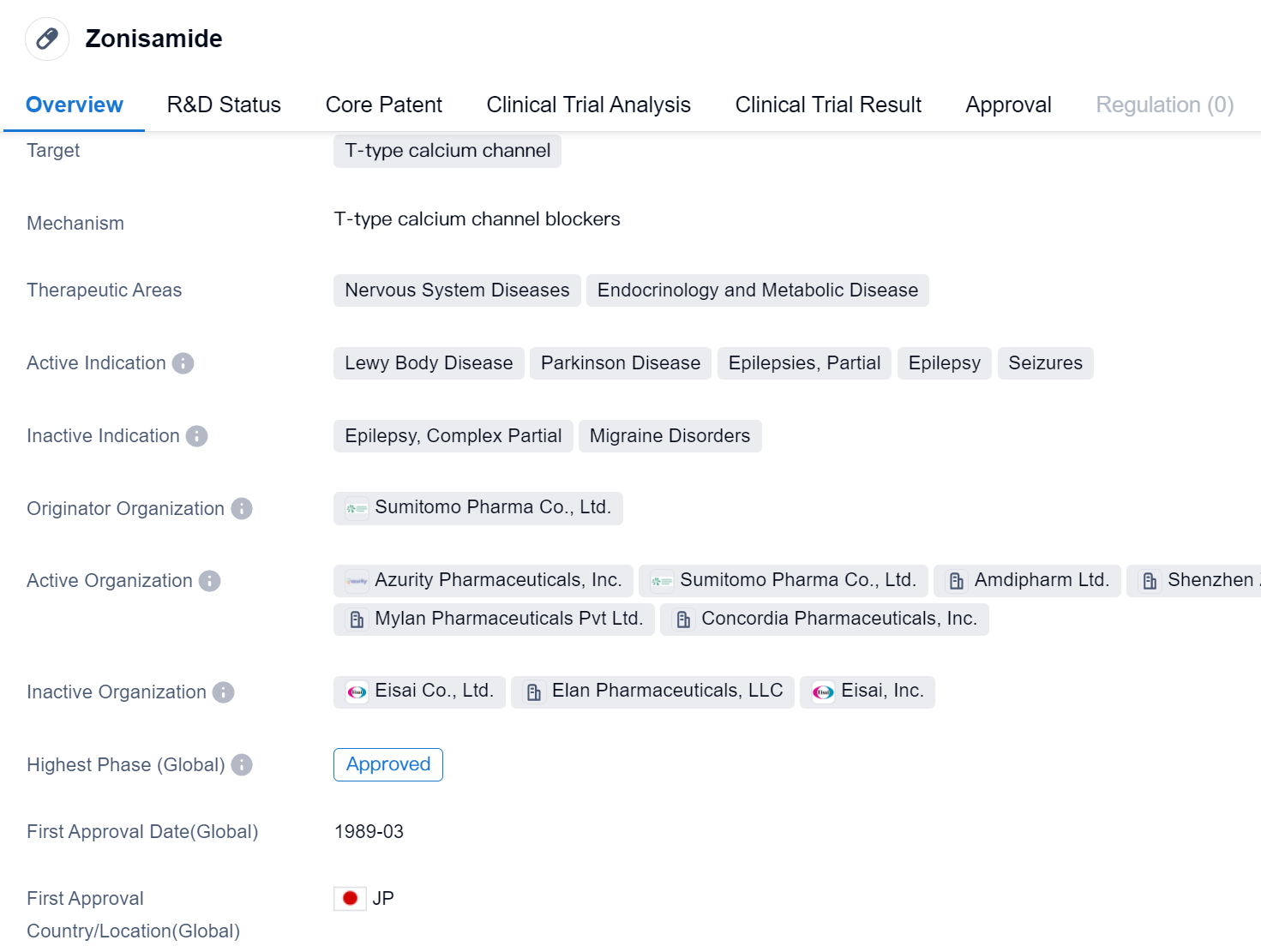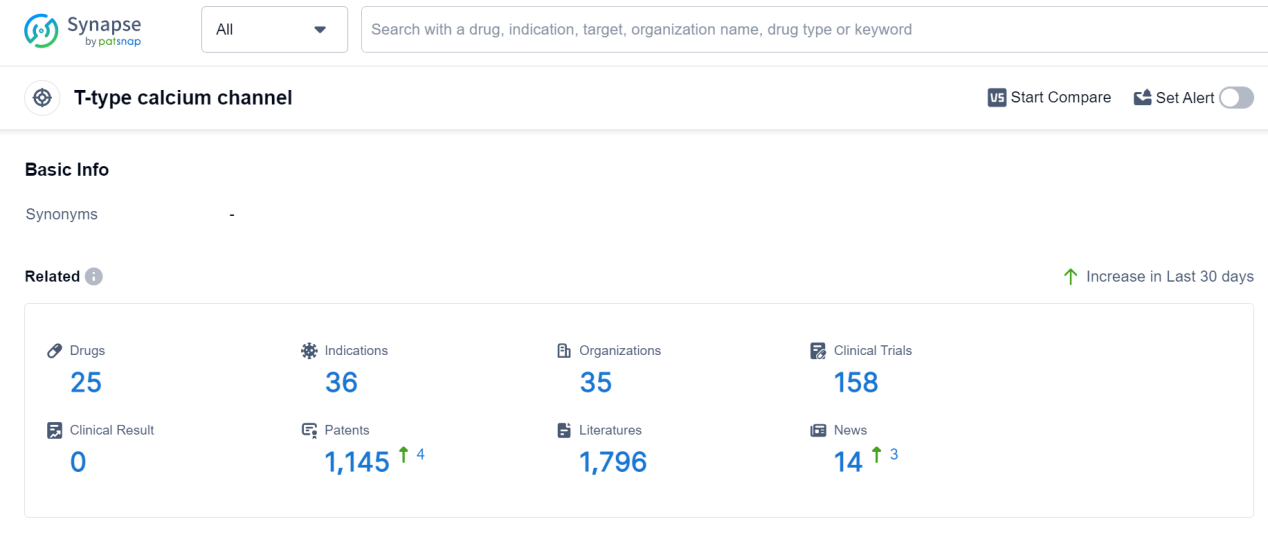A Comprehensive Review of Zonisamide's R&D Innovations and Drug Target Mechanism
Zonisamide's R&D Progress
Zonisamide is a small molecule drug that targets T-type calcium channels. It is primarily used in the treatment of nervous system diseases and endocrinology and metabolic diseases. The drug has been approved for various indications, including Lewy Body Disease, Parkinson Disease, Epilepsies (Partial), and Seizures.
Zonisamide was first approved in Japan in March 1989 by Sumitomo Pharma Co., Ltd., making it one of the earliest drugs in its class to receive regulatory approval. The highest R&D phase of this drug is approved.
As a small molecule drug, zonisamide is designed to interact with T-type calcium channels, which play a crucial role in regulating calcium influx into cells. By targeting these channels, zonisamide can modulate calcium levels and potentially alleviate symptoms associated with nervous system diseases and endocrinology and metabolic diseases.
The therapeutic areas in which zonisamide is indicated suggest its potential in addressing a wide range of conditions affecting the nervous system and metabolic processes. Lewy Body Disease, Parkinson Disease, and epilepsy are all neurological disorders characterized by abnormal brain activity and can result in various symptoms such as tremors, seizures, and cognitive impairment.
👇Please click on the image below to directly access the latest data (R&D Status | Core Patent | Clinical Trial | Approval status in Global countries) of this drug.
Mechanism of Action for Zonisamide: T-type calcium channel blockers
T-type calcium channel blockers are a type of medication that specifically target and block T-type calcium channels in the body. Calcium channels are proteins found in cell membranes that allow the flow of calcium ions into the cells. T-type calcium channels are a specific subtype of these channels.
From a biomedical perspective, T-type calcium channels play a crucial role in various physiological processes, including the regulation of neuronal excitability and the control of cardiac and smooth muscle contraction. By blocking T-type calcium channels, T-type calcium channel blockers can modulate these processes and have therapeutic effects.
In the context of biomedicine, T-type calcium channel blockers are primarily used in the treatment of certain medical conditions. They are commonly prescribed for the management of hypertension (high blood pressure) and certain types of cardiac arrhythmias (abnormal heart rhythms). By blocking T-type calcium channels in the heart and blood vessels, these medications can help reduce blood pressure and regulate heart rhythm.
It's important to note that T-type calcium channel blockers are distinct from other types of calcium channel blockers, such as L-type calcium channel blockers. L-type calcium channel blockers primarily target L-type calcium channels, which are found in cardiac and smooth muscle cells. T-type calcium channel blockers specifically focus on T-type calcium channels, which are more prevalent in neuronal tissues.
Overall, T-type calcium channel blockers are a specific class of medications that act by blocking T-type calcium channels in the body. They are commonly used in the treatment of hypertension and cardiac arrhythmias, providing therapeutic benefits by modulating calcium ion flow in cells.
Drug Target R&D Trends for Zonisamide
T-type calcium channels are a type of voltage-gated calcium channels found in various tissues and organs of the human body. These channels play a crucial role in regulating calcium influx into cells, which is essential for numerous physiological processes. In the central nervous system, T-type calcium channels are involved in controlling neuronal excitability and neurotransmitter release, thereby influencing functions like sleep, pain perception, and epilepsy. Additionally, these channels are also present in the cardiovascular system, where they contribute to regulating heart rate and blood pressure. Understanding the role of T-type calcium channels is important for developing targeted therapies for various neurological and cardiovascular disorders.
According to Patsnap Synapse, as of 7 Sep 2023, there are a total of 25 T-type calcium channel drugs worldwide, from 35 organizations, covering 36 indications, and conducting 158 clinical trials.
👇Please click on the picture link below for free registration or log in directly if you have a freemium account, you can browse the latest research progress on drugs, indications, organizations, clinical trials, clinical results, and drug patents related to this target
Conclusion
Overall, zonisamide is a small molecule drug that targets T-type calcium channels and is approved for the treatment of various nervous system diseases and endocrinology and metabolic diseases. Its approval for indications such as Lewy Body Disease, Parkinson Disease, and epilepsy highlights its potential in managing these conditions. With its long history of approval and originator organization, zonisamide has established itself as a valuable therapeutic option in the pharmaceutical industry.






